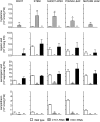Metabolite Diversity in Alkaloid Biosynthesis: A Multilane (Diastereomer) Highway for Camptothecin Synthesis in Camptotheca acuminata
- PMID: 27432874
- PMCID: PMC5006703
- DOI: 10.1105/tpc.16.00193
Metabolite Diversity in Alkaloid Biosynthesis: A Multilane (Diastereomer) Highway for Camptothecin Synthesis in Camptotheca acuminata
Abstract
Camptothecin is a monoterpene indole alkaloid (MIA) used to produce semisynthetic antitumor drugs. We investigated camptothecin synthesis in Camptotheca acuminata by combining transcriptome and expression data with reverse genetics, biochemistry, and metabolite profiling. RNAi silencing of enzymes required for the indole and seco-iridoid (monoterpene) components identified transcriptional crosstalk coordinating their synthesis in roots. Metabolite profiling and labeling studies of wild-type and RNAi lines identified plausible intermediates for missing pathway steps and demonstrated nearly all camptothecin pathway intermediates are present as multiple isomers. Unlike previously characterized MIA-producing plants, C. acuminata does not synthesize 3-α(S)-strictosidine as its central MIA intermediate and instead uses an alternative seco-iridoid pathway that produces multiple isomers of strictosidinic acid. NMR analysis demonstrated that the two major strictosidinic acid isomers are (R) and (S) diastereomers at their glucosylated C21 positions. The presence of multiple diastereomers throughout the pathway is consistent with their use in synthesis before finally being resolved to a single camptothecin isomer after deglucosylation, much as a multilane highway allows parallel tracks to converge at a common destination. A model "diastereomer" pathway for camptothecin biosynthesis in C. acuminata is proposed that fundamentally differs from previously studied MIA pathways.
© 2016 American Society of Plant Biologists. All rights reserved.
Figures










Similar articles
-
Divergent camptothecin biosynthetic pathway in Ophiorrhiza pumila.BMC Biol. 2021 Jun 16;19(1):122. doi: 10.1186/s12915-021-01051-y. BMC Biol. 2021. PMID: 34134716 Free PMC article.
-
ScRNA-seq reveals the spatiotemporal distribution of camptothecin pathway and transposon activity in Camptotheca acuminata shoot apexes and leaves.Physiol Plant. 2024 Sep-Oct;176(5):e14508. doi: 10.1111/ppl.14508. Physiol Plant. 2024. PMID: 39295090
-
Functional characterization of Camptotheca acuminata 7-deoxyloganetic acid synthases and 7-deoxyloganetic acid glucosyltransferases involved in camptothecin biosynthesis.Plant Physiol Biochem. 2025 Jan;218:109305. doi: 10.1016/j.plaphy.2024.109305. Epub 2024 Nov 19. Plant Physiol Biochem. 2025. PMID: 39571455
-
Biotechnological approaches for the production of camptothecin.Appl Microbiol Biotechnol. 2024 Jun 19;108(1):382. doi: 10.1007/s00253-024-13187-2. Appl Microbiol Biotechnol. 2024. PMID: 38896329 Free PMC article. Review.
-
Biotechnology of camptothecin production in Nothapodytes nimmoniana, Ophiorrhiza sp. and Camptotheca acuminata.Appl Microbiol Biotechnol. 2021 Dec;105(24):9089-9102. doi: 10.1007/s00253-021-11700-5. Epub 2021 Dec 1. Appl Microbiol Biotechnol. 2021. PMID: 34850279 Review.
Cited by
-
Identification of WRKY transcription factors involved in regulating the biosynthesis of the anti-cancer drug camptothecin in Ophiorrhiza pumila.Hortic Res. 2022 Apr 22;9:uhac099. doi: 10.1093/hr/uhac099. eCollection 2022. Hortic Res. 2022. PMID: 35795387 Free PMC article.
-
Microwave-Assisted Extraction of Multiple Trace Levels of Intermediate Metabolites for Camptothecin Biosynthesis in Camptotheca acuminata and Their Simultaneous Determination by HPLC-LTQ-Orbitrap-MS/MS and HPLC-TSQ-MS.Molecules. 2019 Feb 25;24(4):815. doi: 10.3390/molecules24040815. Molecules. 2019. PMID: 30823523 Free PMC article.
-
Combined Metabolome and Transcriptome Analyses Reveal the Effects of Mycorrhizal Fungus Ceratobasidium sp. AR2 on the Flavonoid Accumulation in Anoectochilus roxburghii during Different Growth Stages.Int J Mol Sci. 2020 Jan 15;21(2):564. doi: 10.3390/ijms21020564. Int J Mol Sci. 2020. PMID: 31952330 Free PMC article.
-
Comparative analysis of metabolome of rice seeds at three developmental stages using a recombinant inbred line population.Plant J. 2019 Dec;100(5):908-922. doi: 10.1111/tpj.14482. Epub 2019 Sep 4. Plant J. 2019. PMID: 31355982 Free PMC article.
-
Genome-Wide Association Study With Growth-Related Traits and Secondary Metabolite Contents in Red- and White-Heart Chinese Fir.Front Plant Sci. 2022 Jun 30;13:922007. doi: 10.3389/fpls.2022.922007. eCollection 2022. Front Plant Sci. 2022. PMID: 35845628 Free PMC article.
References
-
- Aberham A., Pieri V., Croom E.M. Jr., Ellmerer E., Stuppner H. (2011). Analysis of iridoids, secoiridoids and xanthones in Centaurium erythraea, Frasera caroliniensis and Gentiana lutea using LC-MS and RP-HPLC. J. Pharm. Biomed. Anal. 54: 517–525. - PubMed
-
- Aimi N., Nishimura M., Miwa A., Hoshino H., Sakai S., Haginiwa J. (1989). Pumiloside and deoxypumiloside; plausible intermediate of camptothecin biosynthesis. Tetrahedron Lett. 30: 4991–4994.
-
- Ajala O.S., Piggott A.M., Plisson F., Khalil Z., Huang X., Adesegun S.A., Coker H.A.B., Capon R.J. (2011). Ikirydinium A: a new indole alkaloid from the seeds of Hunteria umbellata (K. Schum). Tetrahedron Lett. 52: 7125–7127.
-
- Arbain D., Putra D.P., Sargent M.V. (1993). The alkaloids of Ophiorrhiza filistipula. Aust. J. Chem. 46: 977–985.
Publication types
MeSH terms
Substances
Grants and funding
LinkOut - more resources
Full Text Sources
Other Literature Sources
Molecular Biology Databases

